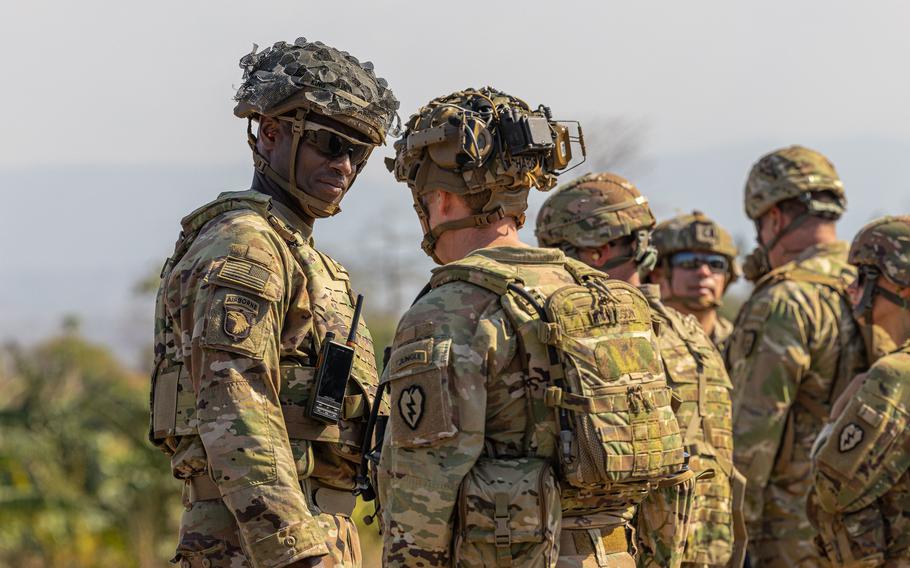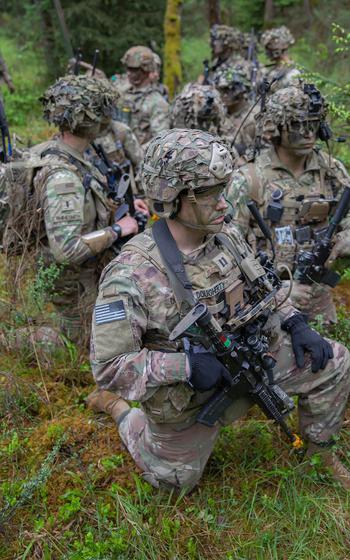
Col. Adisa King, commander of 3rd Brigade, 25th Infantry Division, listens to a soldier during Super Garuda Shield 2024 at Puslatpur 5, Indonesia, on Aug. 31, 2024. Ukraine's efforts at countering Russian disinformation campaigns have worked because its troops aren’t bogged down by a risk-averse U.S.-style chain of command, according to a new Rand Corp. report. (Mariah Aguilar/U.S. Army)
Ukrainian efforts at countering Russian disinformation campaigns have seen success because their troops aren’t bogged down by an overly cautious U.S.-style chain of command, according to a new report that suggests the American military needs to loosen up.
Fear of embarrassing publicity if communication efforts go wrong is one of the driving factors that is holding back the U.S. military, the Rand Corp. said in a study of Ukrainian communication tactics released Tuesday.
“The result of such concerns over risk is that senior (U.S.) government leaders and military commanders often implement cumbersome approval processes that slow response times and are emblematic of a reluctance to take risks in implementing programs,” the report said.
By contrast, the Ukrainian Defense Ministry’s flexibility enabled it to give various outside communication specialists control of its account on Twitter, now known as X, which was a key part of its success in attracting a large audience, Rand said.
“The United States will need to assess its own doctrine, training, and wargaming efforts to ensure it is able to counter disinformation during conflict,” Rand said.
A Ukrainian officer supporting his defense ministry’s communication efforts told Rand that their approach was “trust based” and that it freed up troops to “leverage soldier creativity.”
The U.S. military should learn from the Ukrainian experience, which put a premium on the value of loose coordination to ensure speed in countering Russian propaganda, Rand said.

Capt. Matthew Dougherty, a company commander with the 101st Airborne Division, joins other soldiers in a live-fire exercise at Grafenwoehr Training Area, Germany, on May 7, 2024. Ukrainian efforts at countering Russian disinformation campaigns have proved successful because of greater freedom to produce content than the risk-averse U.S.-style model affords, according to a new Rand Corp. report. (Omar Joseph/U.S. Army)
“However, U.S. government communication efforts are notoriously risk averse and involve significant bureaucratic approval processes,” Rand said. “Senior U.S. government leaders must be willing to accept risk and allow communicators to quickly (without obtrusive senior leader approval chains) create unique, humorous, and engaging content.”
For Ukraine, an aggressive communication campaign that called out false Kremlin narratives in the run-up to Russia’s full-scale invasion in 2022 has carried on throughout the conflict. The effort has helped galvanize international support for Ukraine, whose military relies heavily on Western aid.
Russia has produced large volumes of false content targeted at Ukrainians and global audiences, with the aim of undermining international backing. Rand in the past has described the Kremlin campaign as a “firehose of falsehood.”
False stories about Ukraine included tales about corrupt leaders selling donated weapons on the black market and social media campaigns highlighting high winter heating costs in Europe because of a cutoff from Russian gas.
An onslaught of social media posts calling Ukraine a Nazi state was another common propaganda tactic.
The Russian disinformation campaign also has included deepfake videos of Ukrainian President Volodymyr Zelenskyy urging Ukrainians to surrender and false stories about Ukrainian forces shelling civilian rail stations.
The Ukrainian response has involved a wide array of players, ranging from Zelenskyy himself to Ukrainian social media influencers who have gained international traction.
“The Ukrainian military has also pursued a similar approach with its own social media, with individual soldiers posting directly,” Rand said.
One memorable instance early in the war involved a social media post by a Ukrainian soldier screwing a silencer to the barrel of his gun and telling the camera, “Guys, you’re f----d.”
“Other soldiers, marines, and airmen have used their social media feeds to share slice-of-life videos from the front lines,” the report said.
Such social media posts serve as a “force multiplier” for Ukraine and reach a far greater audience than any centralized command effort could, Rand said.
“The result is that many Americans and Europeans are reminded of the war, its costs, and Ukraine’s tactical victories every time they scroll through Twitter or TikTok,” Rand said.